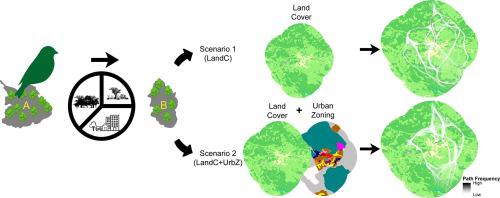Landscape and Urban Planning ( IF 7.9 ) Pub Date : 2021-06-19 , DOI: 10.1016/j.landurbplan.2021.104171 Tulaci Bhakti , João Carlos Pena , Bernardo Brandão Niebuhr , Juliana Sampaio , Fernando Figueiredo Goulart , Cristiano Schetini de Azevedo , Milton Cezar Ribeiro , Yasmine Antonini

|
Cities are new and expanding ecosystems that harbor a variety of habitats with different degrees of permeability to the local fauna. However, the assessment of urban landscape permeability usually considers biotic and abiotic conditions, with sociopolitical dimensions (e.g., zoning regulations) – also important in shaping urban biodiversity – being underrepresented in the formulation of resistance surfaces. Our main goal was to compare urban landscape permeability for birds between two scenarios: one that considers only species’ responses to land cover for the formulation of resistance surfaces (LandC), and another that incorporates how birds would respond to different levels of occupation (i.e., amount of permeable area and maximum building height per individual lot) given the urban zoning regulations defined by the city’s master plan (LandC + UrbZ). We used the software LSCorridors to simulate Multiple Least Cost Corridors (MLCC) for five forest bird species. We hypothesized that incorporating master plan regulations would better describe the variation on landscape resistance through the urban landscape. The simulations resulted in different MLCC among species and between scenarios, highlighted by differences in landscape permeability. As expected, simulations for scenario LandC resulted in more options for straighter paths than simulations for scenario LandC + UrbZ. Our results demonstrate the potential influences of sociopolitical aspects on landscape permeability modelling. Within cities, species movements are influenced not only by behavioral and environmental characteristics, but also by the urban landscape that was shaped by planning and management decisions throughout a city’s history. Therefore, we emphasize that sociopolitical dimensions must be considered when assessing urban landscape permeability.
中文翻译:

结合土地覆盖、动物行为和总体规划法规来评估鸟类的景观渗透性
城市是新的和不断扩大的生态系统,拥有各种对当地动物具有不同程度渗透性的栖息地。然而,城市景观渗透性的评估通常考虑生物和非生物条件,而社会政治维度(例如,分区规定)——在塑造城市生物多样性方面也很重要——在阻力面的制定中代表性不足。我们的主要目标是比较两种情景之间鸟类的城市景观渗透性:一种只考虑物种对土地覆盖的反应来制定阻力面 (LandC),另一种结合鸟类对不同占领水平的反应(即, 考虑到城市总体规划(LandC + UrbZ)定义的城市分区规定,每个地块的渗透面积和最大建筑高度)。我们使用 LSCorridors 软件来模拟五种森林鸟类的多条最低成本走廊 (MLCC)。我们假设纳入总体规划法规将更好地描述城市景观中景观阻力的变化。模拟导致物种之间和情景之间的 MLCC 不同,景观渗透性的差异突出了这一点。正如预期的那样,与情景 LandC + UrbZ 的模拟相比,情景 LandC 的模拟为更直的路径提供了更多选择。我们的结果证明了社会政治方面对景观渗透性建模的潜在影响。在城市内,物种迁移不仅受到行为和环境特征的影响,而且还受到由城市历史上的规划和管理决策所塑造的城市景观的影响。因此,我们强调在评估城市景观渗透性时必须考虑社会政治维度。











































 京公网安备 11010802027423号
京公网安备 11010802027423号